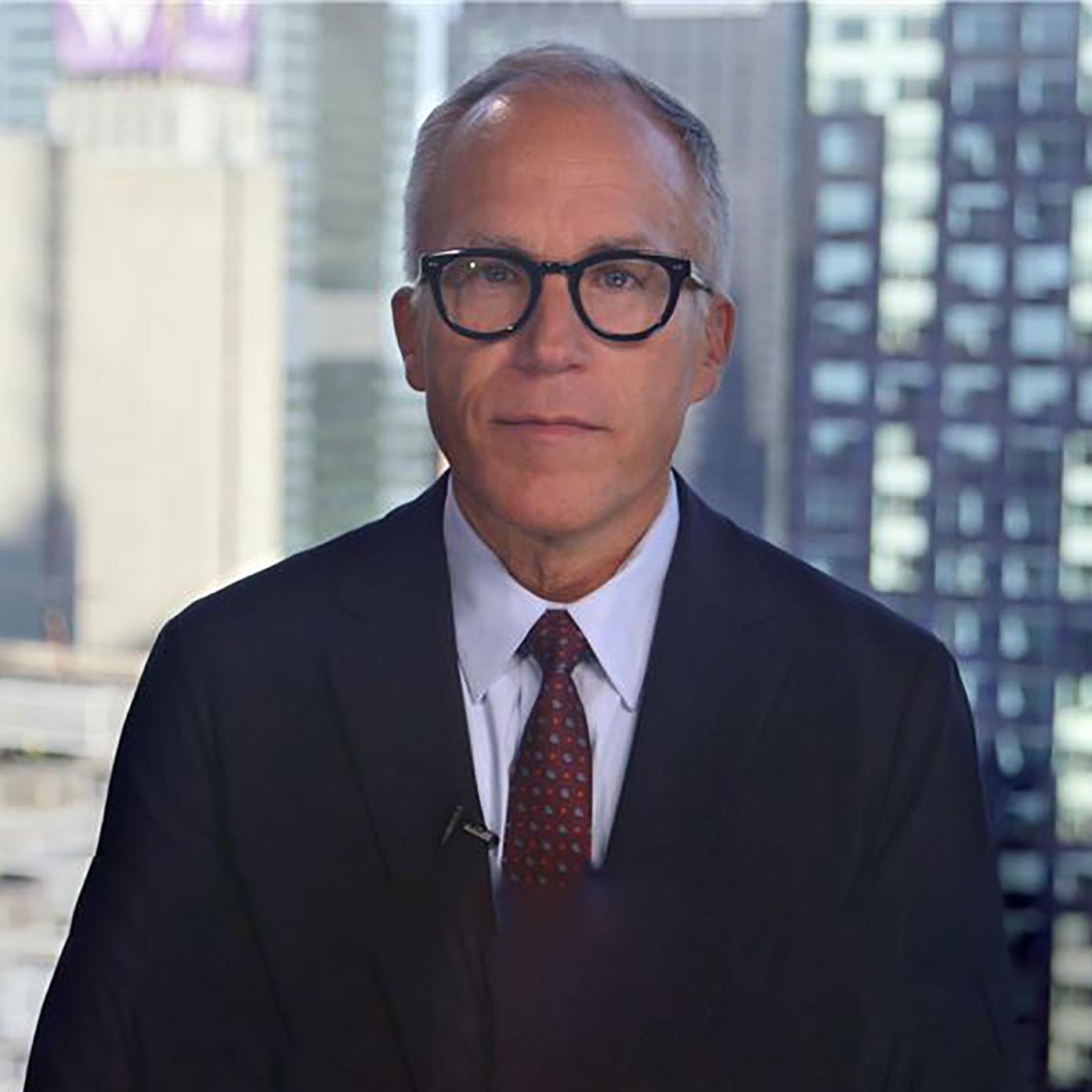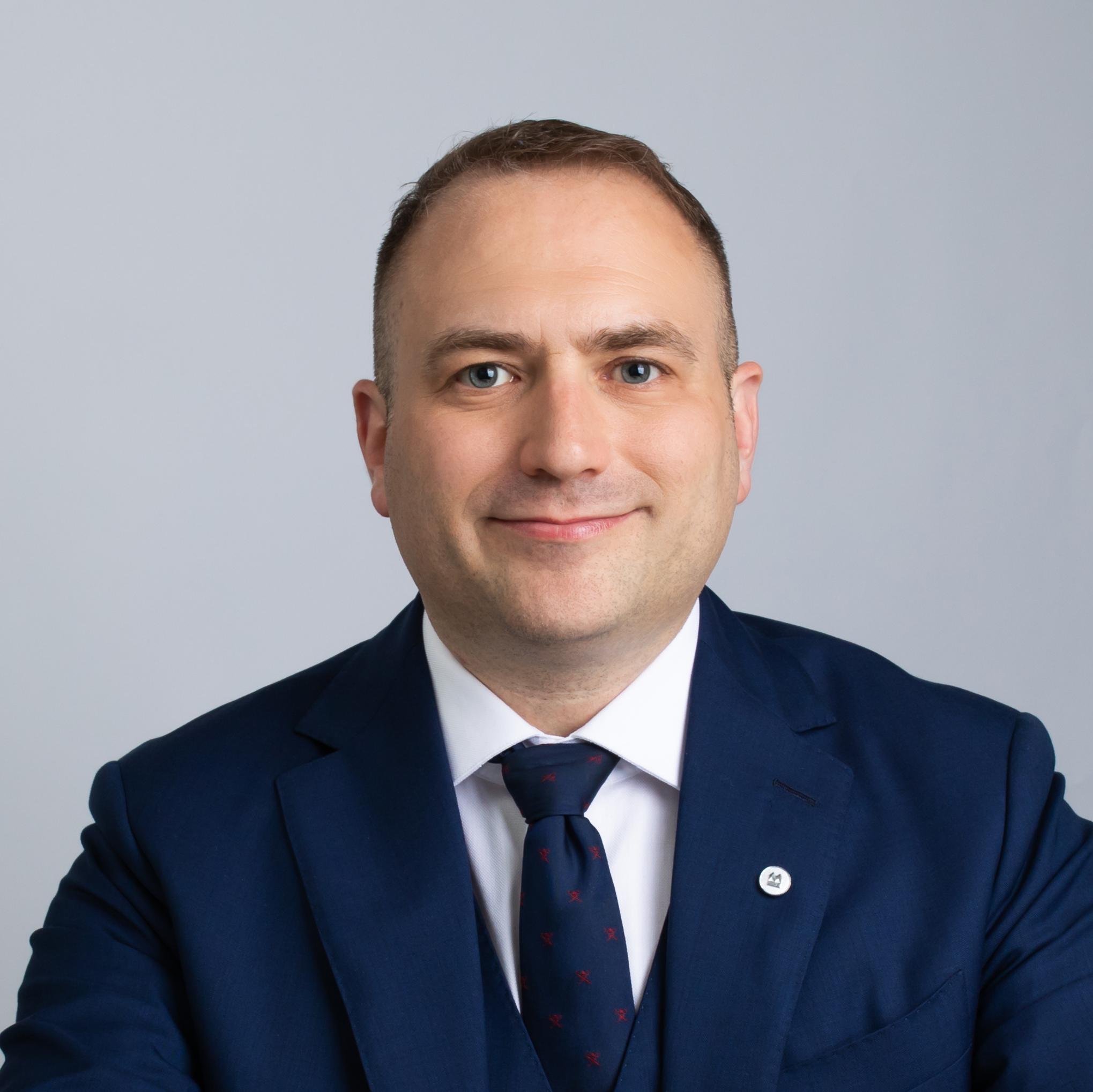
Opportunities in California’s Energy Transition
- Courriel
-
Signet
-
Imprimer
Disponible en anglais seulement
California Resources Corporation (CRC) is the state’s largest oil and gas production company whose focus is not only on meeting the present energy needs of the world’s fifth-largest economy, but also preparing for a lower carbon future.
In the latest episode of Sustainability Leaders, Jonathan Hackett, Managing Director and Head, Sustainable Finance, BMO Capital Markets, sits down with Francisco Leon, President and CEO of CRC, to dive deeper into the topic of energy transition.
Listen to the ~27-minute episode:
Sustainability Leaders podcast is live on all major channels, including Apple and Spotify.
Francisco Leon:
We think that carbon capture and sequestration is an absolute game-changer. We see the technology as viable today and with the ability to make good returns.
Michael Torrance:
Welcome to Sustainability Leaders. I'm Michael Torrance, Chief Sustainability Officer at BMO. On this show, we will talk with leading sustainability practitioners from the corporate, investor, academic, and NGO communities to explore how this rapidly evolving field of sustainability is impacting global investment, business practices, and our world.
Disclosure:
The views expressed here are those of the participants and not those of Bank of Montreal, its affiliates or subsidiaries.
Jonathan Hackett:
Hi, I'm Jonathan Hackett. Welcome to Sustainability Leaders. Today, I'm joined by Francisco Leon from California Resources Corporation, an independent energy and carbon management company committed to the energy transition. Francisco, thanks for joining.
Francisco Leon:
Jonathan, thanks so much for having me. Really excited about the conversation.
Jonathan Hackett:
Likewise. So maybe, Francisco, just to start, CRC has positioned itself as a growing player in the energy transition. With recent progress, including a merger with Aera Energy, and more recently, securing the first class VI well permits for Carbon TerraVault, which would allow for carbon sequestration. Can you paint a picture of what this energy transition looks like for CRC and how it differentiates you in the industry?
Francisco Leon:
Yeah. We actually have a tagline that we're a different kind of energy company. So there's a lot of elements to that story, but we focus on three things. We focus on cashflow, important as a publicly traded company that we have great, sustainable returns to shareholders. So cashflow, first priority. Carbon, as in carbon sequestration and carbon management is a second priority. It's a new business line. It's an exciting part of our story to help decarbonize the industry to help the state of California reach very ambitious objectives around net-zero by lowering the emissions of the state. We want to be this solution for the state. And so carbon management is going to be a platform for growth. So that's a second area of focus. And then the third is California.
Close to 40 million people live here in the state, and big consumers of energy. About one-tenth of the gasoline consumed in the entire US is consumed in California. About one-seventh of the jet fuel is consumed in California. So a lot of consumption of our products today. Big aspiration to move to other types of energy, and we're very supportive of a balanced transition that really takes advantage of the California model, but the California resources as well, and to be able to come up with a platform that delivers on all fronts. It's not just about lowering emissions, which we want to achieve and we're going to help achieve, but it's also about affordability for the consumers. And it's also about reliability of the energy front.
So we think there's a phenomenal opportunity to be the leader in not only where we are today, which is traditional energy, but also focus on the future of the state, the future of the industry that combines the best of what we have today, makes it better, lowers the carbon intensity, but investing in these technologies that could be exciting with CCS and the ability to create clean hydrogen, blue ammonia, renewable natural gas. But we also like geothermal. That's a great base load, clean solution on a go-forward basis. This is all to complement our CCS strategy.
So that's a little bit about where we are today, and excited about us helping lead that transformation of the energy sector for Californians.
Jonathan Hackett:
So obviously, you're working across a lot of technologies there. Maybe let's start first around carbon capture and storage. You have a project like Carbon Terra Vault. Can you help paint a picture of the significance of it for California's energy landscape and how you're contributing to the development of carbon sequestration in California? And obviously, how the class VI well permit fits into that picture.
Francisco Leon:
We've been working for over three years with the Environmental Protection Agency to obtain what's called a Class VI permit for injection of CO₂ into underground reservoirs for permanent storage. So this is a unique project in many ways. But one is, typically, CO₂ is associated with enhanced oil recovery. What we're going to do in California is actually just to permanent sequestration, no enhancement to oil. So this permit has I would say a very strict regulatory profile. Very hard to get to the permit. You need a lot of data. You need to be able to convince the regulator that the CO₂ will not come out of the ground. You need to have a extensive monitoring system. So it's a high bar to achieve this permit. A lot of proposals, a lot of permits in the queue. But especially in this newer permitting process, it's only been two companies. A company in Indiana got their first, and we are number two now. Now, we're the first publicly traded company. We're also the first in California.
Also, another first, the reservoir is a depleted oil and gas reservoir. So we were able to get this permit, and we're off and running into the races. In fact, we announced that we were going with a final investment decision on our first project out of the gate, which is to capture 100,000 tons of CO2 from our gas processing facility there at Elk Hills where this permit was given. And then we have many more permits in the queue. We have four in 2025 in different areas of the state that we are excited to be able to move forward. So not only can we get to first injection in this first project we're targeting end of this year, first dollar made from CCS... So big milestones on this first project. But we also can reach some scalability as we develop other areas.
So maybe if I can take a second to describe the opportunity size, Jonathan. There's about 400 million tons of emissions in California. That's the contribution of the state. And under California law, and as part of the scoping plan from an agency called the California Air Resources Board, the conclusion was that carbon capture and sequestration had to address at least a fourth to a third of those emissions. So anywhere from 150 to 200 million tons needed to be addressable with carbon capture and sequestration. So that means that emitters, CO2 emitters in really any plant factory, manufacturing side, is an emitter of pollution, emitter of CO2, that they needed to have a carbon capture and sequestration as a means to avoid those pollutions. And so the recognized best practice is to do storage underground, and that's the permit that we pursued.
And we've developed sites, as we're the largest mineral acreage holder in the state of California. We also have a lot of surface ownership and surface rights. So we developed a plan that has about 1 billion tons of capacity to store CO2. So that's roughly, if you think about annual, 20 to 25 million tons of emissions that we can capture and sequester and store. So that becomes a significant part of the market that's addressable, at least 10%, if not more. And we're just getting started. So we think the running room here, with the support from California, with the incentives that are available both at the federal level and the state level, are going to lead to, like I said, a very, very long runway to be able to create this business, and we're uniquely positioned to make this successful.
Jonathan Hackett:
That's fantastic. And I think when we talk so often about the transition to net-zero, the hard work initially of getting the base load emissions down to something that's more manageable when you can begin to think about offsetting or the negative emissions that we need for the longer term, it's hard to see a path to making a meaningful dent. But when you were talking about 10% of that target just from this potential sequestration site alone, that's really incredible to be able to talk about that volume there. Going onto that second piece, because when we talk about net-zero, we're also talking about removal. You've received funding from Department of Energy for the California DAC Hub Consortium, where DAC, just for everyone, is direct air capture. Can you tell us more about that project and how it fits into CRC's overall strategy in this space?
Francisco Leon:
Yeah. Our strategy on carbon management, as most of what I've said so far, is really focused on the storage of existing emissions. The second piece that we're very excited about is the removal of carbon from the atmosphere, and that's where direct air capture comes. The Department of Energy wants to establish hubs around the US for direct air capture. And a couple years ago, they funded two projects in other states. So we're vying for that third seat to be able to put direct air capture on the map in California. We were partnering with some of the best technologies in the world, a company out of Switzerland called Climeworks, a company out of LA called AVNOS. They're the ones that are the technology providers around this process. And we want to be the storage site for direct air capture for DAC. So we jointly submitted an application to the deal and got funding for a second-level investment. There's three level. So we're still at that second level, but expect a lot of support for the technology, a lot of exciting opportunities to help California get decarbonized.
You have an incremental incentive through the Inflation Reduction Act, and is the highest form of credit, $185 per ton for direct air capture. And we see a lot of appetite from tech companies and companies in general that want to offset their footprint on the world, and they just have emissions that they can't control or cannot have any way to avoid is buying credits from this direct air capture projects. It's a viable strategy. It's something that's still very early stage, but we're very excited about it, and in partnership with all these groups.
Jonathan Hackett:
You talk about California specifically a lot. In the past you've spoken about the importance of local energy production. How does that picture fit into your view on carbon capture and storage and the reason that you're driving the work there in California?
Francisco Leon:
Yeah, so we're the largest oil and gas producer in California, a big market, big consumers. And as you think about a transition, that will take time. I think that's one of the learnings. There's no easy way to transition today. And in order to build that bridge into the future, you really need to focus first on improvement of what you have. California has a lot of natural resources. And the extraction of those resources for the benefit of people that live in California, we're taking our job very seriously in terms of doing oil and gas better than anybody else on the planet. Not only safety is something we focus on and have a tremendous track record, but also environmental stewardship. So when we look at our operations, and these are verified some of the lowest oil field operations from an emissions standpoint, from methane emissions, really at least in the US and probably worldwide. And we invite groups like MIQ, which is a global recognized leader in verification of methane emissions to come to our sites and ultimately grade how we do. And the first area that we completed in the Los Angeles basin, they awarded us the best grade, an A for lowest methane. Very few companies have received that letter.
So there's an opportunity to improve the oil and gas business today and continue to extract it until we find that better solution. We're also looking to bring enhanced geothermal to extract clean energy from formations that we didn't think worked before, and so on and so forth. So its so synergistic, when you have a long-term view towards creating something really valuable for Californians, is to be able to take care of the present, make it better, lower the carbon intensity of your operations. That local production ultimately also checks the box on affordability, job creation, and ultimately a really good thing for the communities. But also, not saying that's it, right? There's more to do and we need to figure out what's next through carbon capture and everything else we already talked about. So we take that leadership and that responsibility very seriously to not only deliver energy today, but think about where the future energy needs to come from.
Jonathan Hackett:
Yeah, I think the challenge obviously is rather large, right? We're talking about how do we scale up these technologies? How do we scale up to meet this full need? You mentioned this idea that you could be representing 10% of the sequestration goal or the carbon capture and storage goal for California. What are the hurdles that you face in developing and implementing CCS on that large of a scale? How are you addressing those challenges?
Francisco Leon:
There's multiple challenges in permitting and permitting speed. It doesn't match capital returns and the appetite for capital deployment in a large scale. And so we need to align that better. And for our projects, the capital interest was there from day one, but there's a waiting game on permits, a waiting game on getting everything off the ground. And capital can be impatient because there's other options, and it's not dedicated to an area, it needs to be productive. But we got lucky, or we think we have the right game plan. We actually have attracted a lot of capital from Canada. And to highlight our partner, Brookfield, as part of their global transition fund, they allocated $500 million of that fund to help us develop and scale CCS. They're also part of this first reservoir that we just went to FID. And the plan is to have them ultimately be part of every single reservoir that we develop in California through our JV. So that was a great opportunity for us.
Also, our largest shareholder, if you look at our share registry as a publicly traded company, our largest shareholder is the Canadian Pension Plan. CPPIB came in through an acquisition that we did last year. You have a lot of like-minded capital coming in that's looking at our company, CRC, as a company that's doing really well today, but focused on the future in the right way to unlock all these technologies and these investment opportunities that very few people have in the world. So very well integrated in our strategy matches, the objectives.
So the challenges are to get these groups to be able to deploy capital in a way that has attractive returns and delivers the environmental benefits that we're seeking. Being first is not easy, and there's a lot of unknowns out there for us to tackle as you deal with regulation, as you deal with market forces, as you lead with preferences around what we need to do. But we're convinced the world needs to decarbonize, but we're convinced as well that we need reliable, affordable, and local energy. So it's not an either/or, it's a both, and we're taking on that mission with a lot of excitement.
Jonathan Hackett:
So Francisco, one of the things you've talked about is the diversity of approaches that you guys are taking, the number of technologies you're looking at. You mentioned geothermal, for example. Across all of those, what are the most exciting advancements you see on the horizon and how are you thinking about... I think the challenge that a lot of companies face of... You touched on it... The capital and the risk appetite of that capital and how you have one company that is all of these things to all of its investors with different time horizons. How are you thinking about those balances?
Francisco Leon:
Yeah, I think one mistake California can make is, if they pre-select winning technologies at this stage of the game and lead just with, "Only these technologies will work," I think that's a mistake, and it's going to be costly. In order to replace something that works very well, like natural gas and oil, we need to have multiple shots on goal and we need to let the market and the technologies evolve over time, and we need to take the right time to develop them and to make sure they're commercially viable. So with that in mind, I think we were excited about a number of things.
But to the point about not picking winners prematurely, the world changes rapidly, and there's no better reminder than artificial intelligence. And the fairly recent boom in AI that I'm convinced will change the world, change the way we work, will make lives better. But as a consequence, you need massive amounts of power. And the technology that a lot of people said, "well, that's going to be the future," which is renewables, will not be compatible with this AI growth, at least not exclusively. It's part of the equation. There's a lot of places to be excited about for renewables, but it's not the only thing that will work.
Now, things like SMRs and nuclear exciting, but that's not what we do at CRC. So there's room for those and they're definitely excited to see those technologies take off. But in terms of what we can deliver, we can make this carbon capture a reality and take a lot of those plants behind the meter, or they can be part of the grid, but decarbonized and contributing to accommodate the growth that should come with AI power demand.
Similarly, geothermal, we've liked geothermal for many, many years, but it's never been really subsidized. So without enhanced PPAs, power purchase agreements, it's a marginal business at best. And now we see big moves from companies into trying to understand the geothermal resource. And it's another one that aligns extremely well with our strengths as subsurface experts, as drillers, as people that know how to take care of the subsurface, to extract the resource, geothermal is a natural place for us to go, whether it's traditional or the new forms of enhanced geothermal or mechanical earth battery type of work. Those are solutions that need to be proven at scale or need to be purposely developed for these AI needs. I could go on and on. There's a lot of things to get excited about, Jonathan, but those are a few examples.
Jonathan Hackett:
That's really great. You touched on the support from the IRA for your work on carbon sequestration. I think in the last few months there's been a lot of discussion around regulation and changes that we can expect over the coming years. How do you see the regulatory landscape impacting CRC's efforts in this space, both positively and negatively?
Francisco Leon:
Yeah. The IRA was an absolute boost to a lot of our efforts. And I would say if you look at carbon capture under 45 Q... That's the code within the IRA. If you look at whose benefited, what companies have used that to grow their business, it's really energy companies in the so-called red or Republican states. So where it was the Democratic president that ultimately created the IRA, we see this as a very bipartisan solution. I wouldn't feel the same about every aspect of the energy transition. There's clearly some areas that will be at risk, but we see what we develop, which is all adjacent to an oil and gas business that's transforming, as something that should be supported by this administration. We know the support is overwhelming in California. So we think we have a pretty significant momentum here building that we're not overly concerned with the new administration coming in. If we can work on expanding permitting, that would be a bonus, because in a lot of ways you have companies that are very well-prepared to take this on, this challenge. So it's an exciting place to be, and I think we're going to get support when you're creating jobs. So the quality that we are, the support will be there from communities and government as well.
Jonathan Hackett:
And that's a really interesting place maybe to dive in a little more. When you talk about creating jobs and being able to create that energy in the state, does it impact your employees, that they're working at a company that's focused on sustainability, that that's part of the mission of the company? Is that something that you find drives a difference in who wants to work at CRC?
Francisco Leon:
Absolutely. It's in our DNA. And there's a lot of excitement about our Carbon TerraVault business, about carbon management. In fact, I would tell you, we have about 50, 60 people full-time working carbon management. The majority of them are oil and gas employees that have basically moved into this new space in developing great expertise and creating a lot of value. It's no resistance. It's an embrace of where we need to go. It's in the actions taken by our board, by our management. Or if you look at our proxy materials, in terms of how the CRC employees get paid, 30% or so of the annual bonus is around ESG initiatives. It's about changing of pneumatic valves, it's about getting MIT certification. So it's all about incentives, and we're providing the right incentives for the employee base to be excited about this.
Jonathan Hackett:
You've created really a sustainability leader in a category where a lot of people assume that's really hard to do. We talk a lot to companies that are in heavy industry, and one of the things they say is that it's not their core business, that it's easier to just focus on what you do and somebody else will solve some of these problems. How do you think leaders in other emitting industries can build a sustainability leader within their space?
Francisco Leon:
Yeah. It's hard to speak for other industries. A lot of different investors out there, and they have a big say. In some ways, it helps us that we are a California-based company. We live in California. We want to really create not only value to shareholders... I mean, that comes with the territory of being a publicly traded company. But we want to enhance the lives of people around us in our communities, and that creates a mission statement that's probably easier than it is for other companies. But the world is demanding that we do better. And in this heavy industries, profitability key. You have to be able to make money. There's no question about it. But profitability coupled with an improvement of people's lives, decarbonization, doing better on your operational practices, lowering your carbon footprint, are equally, I think, parts of what every companies should have as a core responsibility. I think the scary part for a lot of companies is the view of an either/or, and a transition, a forced transition. So, I respect that. But what we are finding is we can do both. They're not mutually exclusive. The commitment has to be there from the top, not only from my perspective, but the board and the shareholders.
Jonathan Hackett:
Francisco, I think that's really great guidance for others in the space. Really appreciate you taking the time to join us today.
Francisco Leon:
Jonathan, so good to talk to you, and thanks for giving us some space to share some of our exciting projects. Appreciate you and Bank of Montreal to allow us an opportunity to participate in your podcast. Thanks so much.
Michael Torrance:
Thanks for listening to Sustainability Leaders. This podcast is presented by BMO. You can find our show on Apple Podcasts, Spotify, or your favorite podcast player. Press the follow button if you want to get notified when new episodes are published. We value your input, so please leave a rating, review and any feedback you might have, or visit us at bmo.com forward slash sustainability leaders. Our show and resources are produced with support from BMO's marketing team and Puddle Creative. Until next time, thanks for listening and have a great week.
Disclosure:
For BMO disclosures, please visit bmocm.com slash podcast slash disclaimer.

Opportunities in California’s Energy Transition
Premier directeur général et chef, Finance durable, BMO Marchés des capitaux
Jonathan Hackett est premier directeur général et chef, Finance durable à BMO Marchés des capitaux. Il conseille les clients sur les occ…
Jonathan Hackett est premier directeur général et chef, Finance durable à BMO Marchés des capitaux. Il conseille les clients sur les occ…
VOIR LE PROFIL COMPLET-
Temps de lecture
-
Écouter
Arrêter
-
Agrandir | Réduire le texte
Disponible en anglais seulement
California Resources Corporation (CRC) is the state’s largest oil and gas production company whose focus is not only on meeting the present energy needs of the world’s fifth-largest economy, but also preparing for a lower carbon future.
In the latest episode of Sustainability Leaders, Jonathan Hackett, Managing Director and Head, Sustainable Finance, BMO Capital Markets, sits down with Francisco Leon, President and CEO of CRC, to dive deeper into the topic of energy transition.
Listen to the ~27-minute episode:
Sustainability Leaders podcast is live on all major channels, including Apple and Spotify.
Francisco Leon:
We think that carbon capture and sequestration is an absolute game-changer. We see the technology as viable today and with the ability to make good returns.
Michael Torrance:
Welcome to Sustainability Leaders. I'm Michael Torrance, Chief Sustainability Officer at BMO. On this show, we will talk with leading sustainability practitioners from the corporate, investor, academic, and NGO communities to explore how this rapidly evolving field of sustainability is impacting global investment, business practices, and our world.
Disclosure:
The views expressed here are those of the participants and not those of Bank of Montreal, its affiliates or subsidiaries.
Jonathan Hackett:
Hi, I'm Jonathan Hackett. Welcome to Sustainability Leaders. Today, I'm joined by Francisco Leon from California Resources Corporation, an independent energy and carbon management company committed to the energy transition. Francisco, thanks for joining.
Francisco Leon:
Jonathan, thanks so much for having me. Really excited about the conversation.
Jonathan Hackett:
Likewise. So maybe, Francisco, just to start, CRC has positioned itself as a growing player in the energy transition. With recent progress, including a merger with Aera Energy, and more recently, securing the first class VI well permits for Carbon TerraVault, which would allow for carbon sequestration. Can you paint a picture of what this energy transition looks like for CRC and how it differentiates you in the industry?
Francisco Leon:
Yeah. We actually have a tagline that we're a different kind of energy company. So there's a lot of elements to that story, but we focus on three things. We focus on cashflow, important as a publicly traded company that we have great, sustainable returns to shareholders. So cashflow, first priority. Carbon, as in carbon sequestration and carbon management is a second priority. It's a new business line. It's an exciting part of our story to help decarbonize the industry to help the state of California reach very ambitious objectives around net-zero by lowering the emissions of the state. We want to be this solution for the state. And so carbon management is going to be a platform for growth. So that's a second area of focus. And then the third is California.
Close to 40 million people live here in the state, and big consumers of energy. About one-tenth of the gasoline consumed in the entire US is consumed in California. About one-seventh of the jet fuel is consumed in California. So a lot of consumption of our products today. Big aspiration to move to other types of energy, and we're very supportive of a balanced transition that really takes advantage of the California model, but the California resources as well, and to be able to come up with a platform that delivers on all fronts. It's not just about lowering emissions, which we want to achieve and we're going to help achieve, but it's also about affordability for the consumers. And it's also about reliability of the energy front.
So we think there's a phenomenal opportunity to be the leader in not only where we are today, which is traditional energy, but also focus on the future of the state, the future of the industry that combines the best of what we have today, makes it better, lowers the carbon intensity, but investing in these technologies that could be exciting with CCS and the ability to create clean hydrogen, blue ammonia, renewable natural gas. But we also like geothermal. That's a great base load, clean solution on a go-forward basis. This is all to complement our CCS strategy.
So that's a little bit about where we are today, and excited about us helping lead that transformation of the energy sector for Californians.
Jonathan Hackett:
So obviously, you're working across a lot of technologies there. Maybe let's start first around carbon capture and storage. You have a project like Carbon Terra Vault. Can you help paint a picture of the significance of it for California's energy landscape and how you're contributing to the development of carbon sequestration in California? And obviously, how the class VI well permit fits into that picture.
Francisco Leon:
We've been working for over three years with the Environmental Protection Agency to obtain what's called a Class VI permit for injection of CO₂ into underground reservoirs for permanent storage. So this is a unique project in many ways. But one is, typically, CO₂ is associated with enhanced oil recovery. What we're going to do in California is actually just to permanent sequestration, no enhancement to oil. So this permit has I would say a very strict regulatory profile. Very hard to get to the permit. You need a lot of data. You need to be able to convince the regulator that the CO₂ will not come out of the ground. You need to have a extensive monitoring system. So it's a high bar to achieve this permit. A lot of proposals, a lot of permits in the queue. But especially in this newer permitting process, it's only been two companies. A company in Indiana got their first, and we are number two now. Now, we're the first publicly traded company. We're also the first in California.
Also, another first, the reservoir is a depleted oil and gas reservoir. So we were able to get this permit, and we're off and running into the races. In fact, we announced that we were going with a final investment decision on our first project out of the gate, which is to capture 100,000 tons of CO2 from our gas processing facility there at Elk Hills where this permit was given. And then we have many more permits in the queue. We have four in 2025 in different areas of the state that we are excited to be able to move forward. So not only can we get to first injection in this first project we're targeting end of this year, first dollar made from CCS... So big milestones on this first project. But we also can reach some scalability as we develop other areas.
So maybe if I can take a second to describe the opportunity size, Jonathan. There's about 400 million tons of emissions in California. That's the contribution of the state. And under California law, and as part of the scoping plan from an agency called the California Air Resources Board, the conclusion was that carbon capture and sequestration had to address at least a fourth to a third of those emissions. So anywhere from 150 to 200 million tons needed to be addressable with carbon capture and sequestration. So that means that emitters, CO2 emitters in really any plant factory, manufacturing side, is an emitter of pollution, emitter of CO2, that they needed to have a carbon capture and sequestration as a means to avoid those pollutions. And so the recognized best practice is to do storage underground, and that's the permit that we pursued.
And we've developed sites, as we're the largest mineral acreage holder in the state of California. We also have a lot of surface ownership and surface rights. So we developed a plan that has about 1 billion tons of capacity to store CO2. So that's roughly, if you think about annual, 20 to 25 million tons of emissions that we can capture and sequester and store. So that becomes a significant part of the market that's addressable, at least 10%, if not more. And we're just getting started. So we think the running room here, with the support from California, with the incentives that are available both at the federal level and the state level, are going to lead to, like I said, a very, very long runway to be able to create this business, and we're uniquely positioned to make this successful.
Jonathan Hackett:
That's fantastic. And I think when we talk so often about the transition to net-zero, the hard work initially of getting the base load emissions down to something that's more manageable when you can begin to think about offsetting or the negative emissions that we need for the longer term, it's hard to see a path to making a meaningful dent. But when you were talking about 10% of that target just from this potential sequestration site alone, that's really incredible to be able to talk about that volume there. Going onto that second piece, because when we talk about net-zero, we're also talking about removal. You've received funding from Department of Energy for the California DAC Hub Consortium, where DAC, just for everyone, is direct air capture. Can you tell us more about that project and how it fits into CRC's overall strategy in this space?
Francisco Leon:
Yeah. Our strategy on carbon management, as most of what I've said so far, is really focused on the storage of existing emissions. The second piece that we're very excited about is the removal of carbon from the atmosphere, and that's where direct air capture comes. The Department of Energy wants to establish hubs around the US for direct air capture. And a couple years ago, they funded two projects in other states. So we're vying for that third seat to be able to put direct air capture on the map in California. We were partnering with some of the best technologies in the world, a company out of Switzerland called Climeworks, a company out of LA called AVNOS. They're the ones that are the technology providers around this process. And we want to be the storage site for direct air capture for DAC. So we jointly submitted an application to the deal and got funding for a second-level investment. There's three level. So we're still at that second level, but expect a lot of support for the technology, a lot of exciting opportunities to help California get decarbonized.
You have an incremental incentive through the Inflation Reduction Act, and is the highest form of credit, $185 per ton for direct air capture. And we see a lot of appetite from tech companies and companies in general that want to offset their footprint on the world, and they just have emissions that they can't control or cannot have any way to avoid is buying credits from this direct air capture projects. It's a viable strategy. It's something that's still very early stage, but we're very excited about it, and in partnership with all these groups.
Jonathan Hackett:
You talk about California specifically a lot. In the past you've spoken about the importance of local energy production. How does that picture fit into your view on carbon capture and storage and the reason that you're driving the work there in California?
Francisco Leon:
Yeah, so we're the largest oil and gas producer in California, a big market, big consumers. And as you think about a transition, that will take time. I think that's one of the learnings. There's no easy way to transition today. And in order to build that bridge into the future, you really need to focus first on improvement of what you have. California has a lot of natural resources. And the extraction of those resources for the benefit of people that live in California, we're taking our job very seriously in terms of doing oil and gas better than anybody else on the planet. Not only safety is something we focus on and have a tremendous track record, but also environmental stewardship. So when we look at our operations, and these are verified some of the lowest oil field operations from an emissions standpoint, from methane emissions, really at least in the US and probably worldwide. And we invite groups like MIQ, which is a global recognized leader in verification of methane emissions to come to our sites and ultimately grade how we do. And the first area that we completed in the Los Angeles basin, they awarded us the best grade, an A for lowest methane. Very few companies have received that letter.
So there's an opportunity to improve the oil and gas business today and continue to extract it until we find that better solution. We're also looking to bring enhanced geothermal to extract clean energy from formations that we didn't think worked before, and so on and so forth. So its so synergistic, when you have a long-term view towards creating something really valuable for Californians, is to be able to take care of the present, make it better, lower the carbon intensity of your operations. That local production ultimately also checks the box on affordability, job creation, and ultimately a really good thing for the communities. But also, not saying that's it, right? There's more to do and we need to figure out what's next through carbon capture and everything else we already talked about. So we take that leadership and that responsibility very seriously to not only deliver energy today, but think about where the future energy needs to come from.
Jonathan Hackett:
Yeah, I think the challenge obviously is rather large, right? We're talking about how do we scale up these technologies? How do we scale up to meet this full need? You mentioned this idea that you could be representing 10% of the sequestration goal or the carbon capture and storage goal for California. What are the hurdles that you face in developing and implementing CCS on that large of a scale? How are you addressing those challenges?
Francisco Leon:
There's multiple challenges in permitting and permitting speed. It doesn't match capital returns and the appetite for capital deployment in a large scale. And so we need to align that better. And for our projects, the capital interest was there from day one, but there's a waiting game on permits, a waiting game on getting everything off the ground. And capital can be impatient because there's other options, and it's not dedicated to an area, it needs to be productive. But we got lucky, or we think we have the right game plan. We actually have attracted a lot of capital from Canada. And to highlight our partner, Brookfield, as part of their global transition fund, they allocated $500 million of that fund to help us develop and scale CCS. They're also part of this first reservoir that we just went to FID. And the plan is to have them ultimately be part of every single reservoir that we develop in California through our JV. So that was a great opportunity for us.
Also, our largest shareholder, if you look at our share registry as a publicly traded company, our largest shareholder is the Canadian Pension Plan. CPPIB came in through an acquisition that we did last year. You have a lot of like-minded capital coming in that's looking at our company, CRC, as a company that's doing really well today, but focused on the future in the right way to unlock all these technologies and these investment opportunities that very few people have in the world. So very well integrated in our strategy matches, the objectives.
So the challenges are to get these groups to be able to deploy capital in a way that has attractive returns and delivers the environmental benefits that we're seeking. Being first is not easy, and there's a lot of unknowns out there for us to tackle as you deal with regulation, as you deal with market forces, as you lead with preferences around what we need to do. But we're convinced the world needs to decarbonize, but we're convinced as well that we need reliable, affordable, and local energy. So it's not an either/or, it's a both, and we're taking on that mission with a lot of excitement.
Jonathan Hackett:
So Francisco, one of the things you've talked about is the diversity of approaches that you guys are taking, the number of technologies you're looking at. You mentioned geothermal, for example. Across all of those, what are the most exciting advancements you see on the horizon and how are you thinking about... I think the challenge that a lot of companies face of... You touched on it... The capital and the risk appetite of that capital and how you have one company that is all of these things to all of its investors with different time horizons. How are you thinking about those balances?
Francisco Leon:
Yeah, I think one mistake California can make is, if they pre-select winning technologies at this stage of the game and lead just with, "Only these technologies will work," I think that's a mistake, and it's going to be costly. In order to replace something that works very well, like natural gas and oil, we need to have multiple shots on goal and we need to let the market and the technologies evolve over time, and we need to take the right time to develop them and to make sure they're commercially viable. So with that in mind, I think we were excited about a number of things.
But to the point about not picking winners prematurely, the world changes rapidly, and there's no better reminder than artificial intelligence. And the fairly recent boom in AI that I'm convinced will change the world, change the way we work, will make lives better. But as a consequence, you need massive amounts of power. And the technology that a lot of people said, "well, that's going to be the future," which is renewables, will not be compatible with this AI growth, at least not exclusively. It's part of the equation. There's a lot of places to be excited about for renewables, but it's not the only thing that will work.
Now, things like SMRs and nuclear exciting, but that's not what we do at CRC. So there's room for those and they're definitely excited to see those technologies take off. But in terms of what we can deliver, we can make this carbon capture a reality and take a lot of those plants behind the meter, or they can be part of the grid, but decarbonized and contributing to accommodate the growth that should come with AI power demand.
Similarly, geothermal, we've liked geothermal for many, many years, but it's never been really subsidized. So without enhanced PPAs, power purchase agreements, it's a marginal business at best. And now we see big moves from companies into trying to understand the geothermal resource. And it's another one that aligns extremely well with our strengths as subsurface experts, as drillers, as people that know how to take care of the subsurface, to extract the resource, geothermal is a natural place for us to go, whether it's traditional or the new forms of enhanced geothermal or mechanical earth battery type of work. Those are solutions that need to be proven at scale or need to be purposely developed for these AI needs. I could go on and on. There's a lot of things to get excited about, Jonathan, but those are a few examples.
Jonathan Hackett:
That's really great. You touched on the support from the IRA for your work on carbon sequestration. I think in the last few months there's been a lot of discussion around regulation and changes that we can expect over the coming years. How do you see the regulatory landscape impacting CRC's efforts in this space, both positively and negatively?
Francisco Leon:
Yeah. The IRA was an absolute boost to a lot of our efforts. And I would say if you look at carbon capture under 45 Q... That's the code within the IRA. If you look at whose benefited, what companies have used that to grow their business, it's really energy companies in the so-called red or Republican states. So where it was the Democratic president that ultimately created the IRA, we see this as a very bipartisan solution. I wouldn't feel the same about every aspect of the energy transition. There's clearly some areas that will be at risk, but we see what we develop, which is all adjacent to an oil and gas business that's transforming, as something that should be supported by this administration. We know the support is overwhelming in California. So we think we have a pretty significant momentum here building that we're not overly concerned with the new administration coming in. If we can work on expanding permitting, that would be a bonus, because in a lot of ways you have companies that are very well-prepared to take this on, this challenge. So it's an exciting place to be, and I think we're going to get support when you're creating jobs. So the quality that we are, the support will be there from communities and government as well.
Jonathan Hackett:
And that's a really interesting place maybe to dive in a little more. When you talk about creating jobs and being able to create that energy in the state, does it impact your employees, that they're working at a company that's focused on sustainability, that that's part of the mission of the company? Is that something that you find drives a difference in who wants to work at CRC?
Francisco Leon:
Absolutely. It's in our DNA. And there's a lot of excitement about our Carbon TerraVault business, about carbon management. In fact, I would tell you, we have about 50, 60 people full-time working carbon management. The majority of them are oil and gas employees that have basically moved into this new space in developing great expertise and creating a lot of value. It's no resistance. It's an embrace of where we need to go. It's in the actions taken by our board, by our management. Or if you look at our proxy materials, in terms of how the CRC employees get paid, 30% or so of the annual bonus is around ESG initiatives. It's about changing of pneumatic valves, it's about getting MIT certification. So it's all about incentives, and we're providing the right incentives for the employee base to be excited about this.
Jonathan Hackett:
You've created really a sustainability leader in a category where a lot of people assume that's really hard to do. We talk a lot to companies that are in heavy industry, and one of the things they say is that it's not their core business, that it's easier to just focus on what you do and somebody else will solve some of these problems. How do you think leaders in other emitting industries can build a sustainability leader within their space?
Francisco Leon:
Yeah. It's hard to speak for other industries. A lot of different investors out there, and they have a big say. In some ways, it helps us that we are a California-based company. We live in California. We want to really create not only value to shareholders... I mean, that comes with the territory of being a publicly traded company. But we want to enhance the lives of people around us in our communities, and that creates a mission statement that's probably easier than it is for other companies. But the world is demanding that we do better. And in this heavy industries, profitability key. You have to be able to make money. There's no question about it. But profitability coupled with an improvement of people's lives, decarbonization, doing better on your operational practices, lowering your carbon footprint, are equally, I think, parts of what every companies should have as a core responsibility. I think the scary part for a lot of companies is the view of an either/or, and a transition, a forced transition. So, I respect that. But what we are finding is we can do both. They're not mutually exclusive. The commitment has to be there from the top, not only from my perspective, but the board and the shareholders.
Jonathan Hackett:
Francisco, I think that's really great guidance for others in the space. Really appreciate you taking the time to join us today.
Francisco Leon:
Jonathan, so good to talk to you, and thanks for giving us some space to share some of our exciting projects. Appreciate you and Bank of Montreal to allow us an opportunity to participate in your podcast. Thanks so much.
Michael Torrance:
Thanks for listening to Sustainability Leaders. This podcast is presented by BMO. You can find our show on Apple Podcasts, Spotify, or your favorite podcast player. Press the follow button if you want to get notified when new episodes are published. We value your input, so please leave a rating, review and any feedback you might have, or visit us at bmo.com forward slash sustainability leaders. Our show and resources are produced with support from BMO's marketing team and Puddle Creative. Until next time, thanks for listening and have a great week.
Disclosure:
For BMO disclosures, please visit bmocm.com slash podcast slash disclaimer.
Autre contenu intéressant

Tom Steyer : Les solutions climatiques devraient rendre la vie plus facile et meilleure
Un plus grand nombre d’entreprises américaines et canadiennes se tournent vers la lutte contre les changements climatiques en raison des attentes de leurs clients : Résultats du sondage
L’importance croissante de la résilience des chaînes d’approvisionnement

L’aspect économique de l’élimination du carbone : un entretien avec Deep Sky

Financement des minéraux critiques : Occasions d’élaborer de nouveaux cadres de placement

Élargissement de l’accès à l’énergie solaire : Leçons tirées par GRID Alternatives
A Buyer’s Guide to Corporate Offsetting and Navigating the Voluntary Carbon Market

Validating Breakthrough Energy Concepts, a Discussion with George Hathaway

How Developers and Builders Are Paving the Way for a Greener Future

From Farm to Future: How Funding Solutions are Shaping Agricultural Emissions
Questions et réponses : Pourquoi la déclaration volontaire des émissions devrait-elle être une priorité?
Pourquoi la durabilité est une source de bonnes affaires : Principaux points retenus du Forum économique international des Amériques (FEIA) de 2024, à Toronto
Comprendre l’incidence de la biodiversité sur les entreprises

Building for Tomorrow: Real Estate, Construction, and Sustainability
Les femmes entrepreneures favorisent la durabilité : réflexion sur les résultats du défi WE Empower lié aux objectifs de développement durable des Nations Unies
Pourquoi une politique liée à la chaleur extrême est importante pour les entreprises
Stratégies climatiques dans le secteur de l’immobilier commercial : gérer les risques

Immeubles résidentiels à logements multiples carboneutres au Canada : Analyse du coût et de la valeur de l’actif

BMO Equity Research on the AI + Data Center Build Out: Sustainability Impacts, Second Order Beneficiaries
Comment les entreprises peuvent s’y retrouver dans le cadre de la politique climatique du Canada

Le coût des risques climatiques dans le secteur agricole aux États-Unis
Une première dans l'Ouest canadien : Avenue Living tire parti du programme d'amélioration écoénergétique de BMO pour ajouter 179 nouveaux logements locatifs dans le centre-ville d'Edmonton

Making Renewable Energy Technology Accessible to Underserved Communities: GRID Alternatives in Conversation

Comptabilisation du carbone : Comment renforcer les plans climatiques des entreprises

Les progrès de la technologie des batteries alimentent l’optimisme au sujet de l’industrie des VE
Le coût des plans d’action des entreprises en matière de climat

Les femmes jouent un rôle de premier plan dans le domaine du climat et du développement durable
Risque climatique : changements réglementaires à surveiller en 2024

Le rôle de l’exploitation minière responsable dans la transition vers les énergies propres : entretien avec Rohitesh Dhawan, chef de la direction de l’ICMM

Comment la NASA et IBM utilisent les données géospatiales et l’intelligence artificielle pour analyser les risques climatiques
Décloisonner le développement durable pour l’intégrer aux fonctions de base
L’obligation de publier de l’information sur les facteurs ESG est le signe d’un marché arrivé à maturité
BMO organise un financement vert pour financer le nouveau Lawson Centre for Sustainability, la construction la plus importante de Trinity College depuis un siècle
BMO se classe parmi les sociétés les plus durables d'Amérique du Nord selon les indices de durabilité Dow Jones
Le Canada a l’occasion de devenir un chef de file mondial de l’élimination du dioxyde de carbone

Températures extrêmes : comment les villes nord-américaines amplifient-elles le changement climatique?

Questions climatiques : rôle de plus en plus important des hauts dirigeants
Un plus grand nombre d’entreprises ont des plans pour lutter contre les changements climatiques en raison de l’importance croissante qu’ils revêtent sur leurs activités : Résultats du sondage
Selon un sondage réalisé par l'Institut pour le climat de BMO auprès des chefs d'entreprise, près de la moitié des chefs d'entreprise des États-Unis et du Canada croient que les changements climatique

Transforming the Textile Industry: Apparel Impact Institute in Conversation
L’électrification constitue une occasion unique dans le cadre de la transition énergétique
Questions et réponses : comment transformer les défis économiques en possibilités
Le soutien du secteur de l’énergie dans l’atteinte des objectifs de décarbonisation du Canada
Trois idées inspirées de la Semaine du climat pour passer à l’action à la COP28

Protecting Outdoor Spaces: The Conservation Alliance in Conversation

Building Meaningful Connections with Nature: Parks California in Conversation
Du caractère essentiel du financement pour doper les technologies d’élimination du carbone
Transformer le système alimentaire mondial au bénéfice des investisseurs et de la planète
Pourquoi les entreprises doivent accélérer leurs efforts pour lutter contre les changements climatiques
BMO Donates $3 Million to GRID Alternatives to Provide Solar Energy Solutions for Low-Income Families
Banco do Brasil and BMO Financial Group to Introduce First-of-its-Kind Program to Provide Sustainability-Linked Trade Loans Supporting Brazilian Exporters

Comment les investissements dans le captage du carbone peuvent générer des crédits carbone

Free, Prior and Informed Consent (FPIC): Mark Podlasly in Conversation

Comment les concessionnaires automobiles contribuent à la transition vers la carboneutralité

Les feux de forêt au Canada brûlent toujours: explications d’experts
BMO fournit un nouveau produit innovant, le dépôt lié à la durabilité, à Zurn Elkay Water Solutions

Quick Listen: Michael Torrance on Empowering Your Organization to Operationalize Sustainability
BMO seule grande banque nommée au palmarès des 50 meilleures entreprises citoyennes au Canada

Quick Listen: Darryl White on the Importance of US-Canada Partnership
Un investissement rentable : la rénovation comme moyen d’atteindre la carboneutralité
Évolution du marché du carbone : ce qu’en pensent les principaux acteurs
BMO et Bell Canada mettent en œuvre un produit dérivé innovant lié à la durabilité et à des objectifs ambitieux de réduction des émissions de gaz à effet de serre
BMO fait partie d'un groupe convoqué par l'ONU qui conseille les banques mondiales sur l'établissement d'objectifs liés à la nature
Les chefs de file de l’investissement intensifient leurs efforts en vue d’atteindre l’objectif net zéro
Favoriser les innovations technologiques pour renforcer la résilience face aux changements climatiques
BMO célèbre le Jour de la Terre avec la 3e édition annuelle du programme Des transactions qui font pousser des arbres dans ses salles des marchés mondiaux
BMO Donates $2 Million to the University of Saskatchewan to Accelerate Research Critical to the Future of Food
Le temps presse pour les solutions au changement climatique - Sommet Canada-États-Unis

North America’s Critical Minerals Advantage: Deep Dive on Community Engagement
Réchauffement climatique : le GIEC lance son dernier avertissement de la décennie
La confiance est la denrée la plus précieuse : Message de l’ICMM à la Conférence mondiale sur les mines, métaux et minéraux critiques de BMO
Exploration des avantages de l’extraction de minéraux critiques en Amérique du Nord dans le cadre de la Conférence mondiale sur les mines, métaux et minéraux critiques
Les légendes du roc réfléchissent aux réussites et aux échecs de l’industrie minière lors de la Conférence mondiale sur les mines, métaux et minéraux critiques
Explorer les risques et les possibilités associés aux notations ESG dans le secteur minier
BMO Experts at our 32nd Global Metals, Mining & Critical Minerals Conference

Evolving Mining for a Sustainable Energy Transition: ICMM CEO Rohitesh Dhawan in Conversation

BMO Equity Research on BMO Radicle and the World of Carbon Credits

Public Policy and the Energy Transition: Howard Learner in Conversation

Taskforce on Nature-Related Financial Disclosure (TNFD) – A Plan for Integrating Nature into Business
Points à retenir du sondage sur le climat des petites et moyennes entreprises réalisé par l’Institut pour le climat de BMO
BMO nommée banque la plus durable d'Amérique du Nord par Corporate Knights pour la quatrième année d'affilée
Le financement vert du nucléaire : nouvelle frontière de la transition énergétique?

ESG Trends in the Base Metal and Diversified Mining Industries: BMO Equity Research Report
Assurer l’avenir des approvisionnements alimentaires : le rôle de l’Amérique du Nord
BMO s'est classé parmi les entreprises les plus durables en Amérique du Nord selon les indices de durabilité Dow Jones
Un sondage de l'Institut pour le climat de BMO révèle que les coûts et les priorités concurrentes ralentissent l'action climatique des petites et moyennes entreprises
Gérer et monétiser votre transition vers un monde carboneutre avec BMO et Radicle
BMO est l'institution financière la mieux classée selon le Global Sustainability Benchmark, le nouvel indice de référence mondial du développement durable annoncé lors de la COP 27

COP27 : Les problèmes de sécurité énergétique et l’incertitude économique ralentiront-t-ils la transition climatique?
BMO investira dans les crédits compensatoires de carbone novateurs de CarbonCure pour stocker du CO₂ de façon permanente
Financement commercial : vers le développement durable, une entreprise à la fois

RoadMap Project: An Indigenous-led Paradigm Shift for Economic Reconciliation
Une première canadienne : BMO et l'Université Concordia s'unissent pour un avenir durable grâce à un prêt innovant lié à la durabilité

On-Farm Carbon and Emissions Management: Opportunities and Challenges

Intégration des facteurs ESG dans les petites et moyennes entreprises : Conférence de Montréal
BMO entend racheter Radicle Group Inc., un chef de file des services environnementaux situé à Calgary

Investment Opportunities for a Net-Zero Economy: A Conversation at the Milken Institute Global Conference
S’ajuster face aux changements climatiques : l’Institut pour le climat de BMO

How Hope, Grit, and a Hospital Network Saved Maverix Private Capital Founder John Ruffolo

Hydrogen’s Role in the Energy Transition: Matt Fairley in Conversation

Key Takeaways on Ag, Food, Fertilizer & ESG from BMO’s Farm to Market Conference
Les risques physiques et liés à la transition auxquels font face l’alimentation et l’agriculture

Building an ESG Business Case in the Food Sector: The Food Institute
BMO et EDC annoncent une collaboration pour présenter des solutions de financement durable aux entreprises canadiennes

Financer la transition vers la carboneutralité : une collaboration entre EDC et BMO

Refonte au Canada pour un monde carboneutre : Conversation avec Corey Diamond d’Efficacité énergétique Canada

The Role of Hydrogen in the Energy Transition: FuelCell Energy CEO Jason Few in Conversation

BMO est fier de soutenir la première transaction d'obligations vertes du gouvernement du Canada en tant que cochef de file
Article d’opinion: Le Canada peut être un leader en matière de sécurité énergétique
Les mesures prises par le gouvernement peuvent contribuer à stimuler la construction domiciliaire afin de remédier à la pénurie de logements au Canada

Tackling Climate Change in Metals and Mining: ICMM CEO Rohitesh Dhawan in Conversation
La circulaire de sollicitation de procurations et les rapports sur la durabilité 2021 de BMO sont maintenant disponibles

Why Changing Behaviour is Key to a Low Carbon Future – Dan Barclay
BMO lance le programme Services aux entreprises à portée de main - BMO pour les entrepreneurs noirs et annonce un engagement de 100 millions de dollars en prêts pour aider les entrepreneurs noirs à dé

The Post 2020 Biodiversity Framework – A Discussion with Basile Van Havre
BMO annonce son intention de se joindre au programme Catalyst de Breakthrough Energy pour accélérer l'innovation climatique
BMO Groupe financier nommé banque la plus durable en Amérique du Nord pour la troisième année d'affilée

Using Geospatial Big Data for Climate, Finance and Sustainability
Atténuer les répercussions des changements climatiques sur les actifs physiques par la finance spatiale
BMO aide Boralex à aller Au-delà des énergies renouvelables en transformant sa facilité de crédit en un prêt lié au développement durable

The Global Energy Transition: Darryl White & John Graham Discuss
Première mondiale : BMO soutient Bruce Power avec le premier cadre de financement vert du secteur nucléaire au monde
BMO se classe parmi les entreprises les plus durables au monde, selon les indices de durabilité Dow Jones
COP26 : Pourquoi les entreprises doivent assumer leur responsabilité sociale

The Risk of Permafrost Thaw on People, Infrastructure & Our Future Climate

Climate Change & Flood Risk: Implications for Real Estate Markets
The Future of Remote Work and Diversity in the Asset Management Industry

Director of ESG at BMO Talks COP26 & the Changing ESG Landscape
Changer les comportements est essentiel pour assurer un avenir à faible émission de carbone – Table ronde Milken
BMO aide Teck Resources à progresser vers ses objectifs ESG avec un prêt lié à la durabilité

Candidature du Canada pour accueillir le nouveau siège social de l'ISSB
Première dans le secteur des métaux et des mines en Amérique du Nord : BMO aide Sandstorm Gold Royalties à atteindre ses objectifs ESG grâce à un prêt lié à la durabilité
Éducation, emploi et autonomie économique : BMO publie Wîcihitowin ᐑᒋᐦᐃᑐᐏᐣ, son premier Rapport sur les partenariats et les progrès en matière autochtone annuel

Comprendre la Journée nationale de la vérité et de la réconciliation

Comprendre la Journée nationale de la vérité et de la réconciliation

Combler l’écart de richesse entre les groupes raciaux grâce à des actions mesurables
BMO annonce un engagement de financement de 12 milliards de dollars pour le logement abordable au Canada
Investing in Real Estate Sustainability with Bright Power Inc.
In support of Canada’s bid to host the headquarters of the International Sustainability Standards Board
BMO appuie la candidature du Canada pour accueillir le siège du Conseil des normes internationales d'information sur la durabilité
BMO nommé au classement des 50 meilleures entreprises citoyennes au Canada de Corporate Knights
ESG From Farm to Fork: Doing Well by Doing Good

Biggest Trends in Food and Ag, From ESG to Inflation to the Supply Chain
Banques centrales, changements climatiques et leadership : Forum annuel destiné aux femmes œuvrant dans le secteur des titres à revenu fixe, devises et produits de base
BMO met sur pied une nouvelle équipe innovatrice pour la transition énergétique
L’appétit croissant pour l’investissement dans un but précis dans les valeurs à revenu fixe par Magali Gable
Première nord-américaine : BMO aide Gibson Energy à transformer entièrement une facilité de crédit en un prêt lié à la durabilité
Le programme Des transactions qui font pousser des arbres permettra d’en planter 100 000

Understanding Biodiversity Management: Best Practices and Innovation
Les arbres issus des métiers bénéficient d'un marché obligataire ESG solide

The Changing Face of Sustainability: tentree for a Greener Planet

Favoriser l’autonomisation dans une perspective d’équité raciale et de genre
Favoriser des résultats durables : le premier prêt vert offert au Canada

Episode 31: Valuing Natural Capital – A Discussion with Pavan Sukhdev

Episode 29: What 20 Years of ESG Engagement Can Teach Us About the Future
Rapport sur les perspectives de 2021 de BMO Gestion mondiale d'actifs : des jours meilleurs à venir

Episode 28: Bloomberg: Enhancing ESG Disclosure through Data-Driven Solutions
Comment Repérer L’écoblanchiment Et Trouver Un Partenaire Qui Vous Convient
BMO se classe parmi les entreprises les plus durables selon l'indice de durabilité Dow Jones - Amérique du Nord

Episode 27: Preventing The Antimicrobial Resistance Health Crisis
BMO investit dans un avenir durable grâce à un don d’un million de dollars à l’Institute for Sustainable Finance
BMO Groupe financier franchit une étape clé en faisant correspondre 100 pour cent de sa consommation d'électricité avec des énergies renouvelables
BMO Groupe financier reconnu comme l'une des sociétés les mieux gérées de manière durable au monde dans le nouveau classement du Wall Street Journal

Episode 25: Achieving Sustainability In The Food Production System

Episode 23: TC Transcontinental – A Market Leader in Sustainable Packaging
Les possibilités de placement durables dans le monde d’après la pandémie
Les sociétés axées sur l’efficacité énergétique peuvent maintenant réduire leurs coûts d’emprunt

Episode 16: Covid-19 Implications and ESG Funds with Jon Hale
BMO Groupe financier s'approvisionnera à 100 pour cent en électricité à partir d'énergies renouvelables

Episode 13: Faire face à la COVID-19 en optant pour des solutions financières durables

Épisode 09 : Le pouvoir de la collaboration en matière d'investissement ESG

Épisode 08 : La tarification des risques climatiques, avec Bob Litterman

Épisode 07 : Mobiliser les marchés des capitaux en faveur d’une finance durable

Épisode 06 : L’investissement responsable – Tendances et pratiques exemplaires canadiennes

Épisode 04 : Divulgation de renseignements relatifs à la durabilité : Utiliser le modèle de SASB

Épisode 03 : Taxonomie verte: le plan d'action pour un financement durable de l'UE

Épisode 02 : Analyser les risques climatiques pour les marchés financiers












